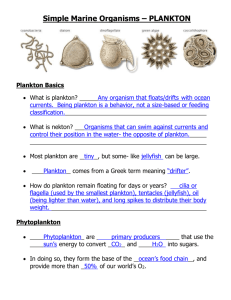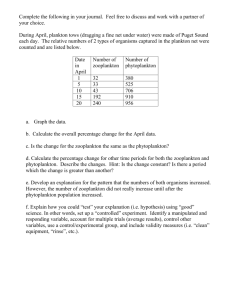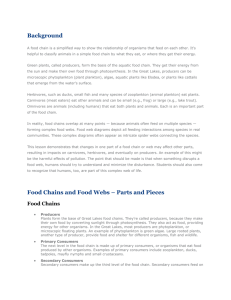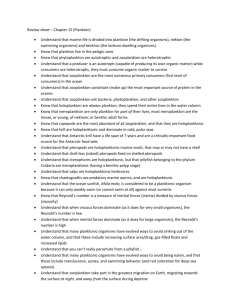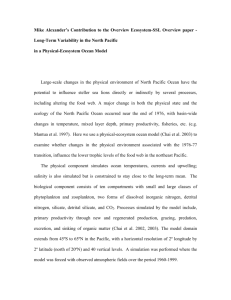plankton - Sea Grant
advertisement
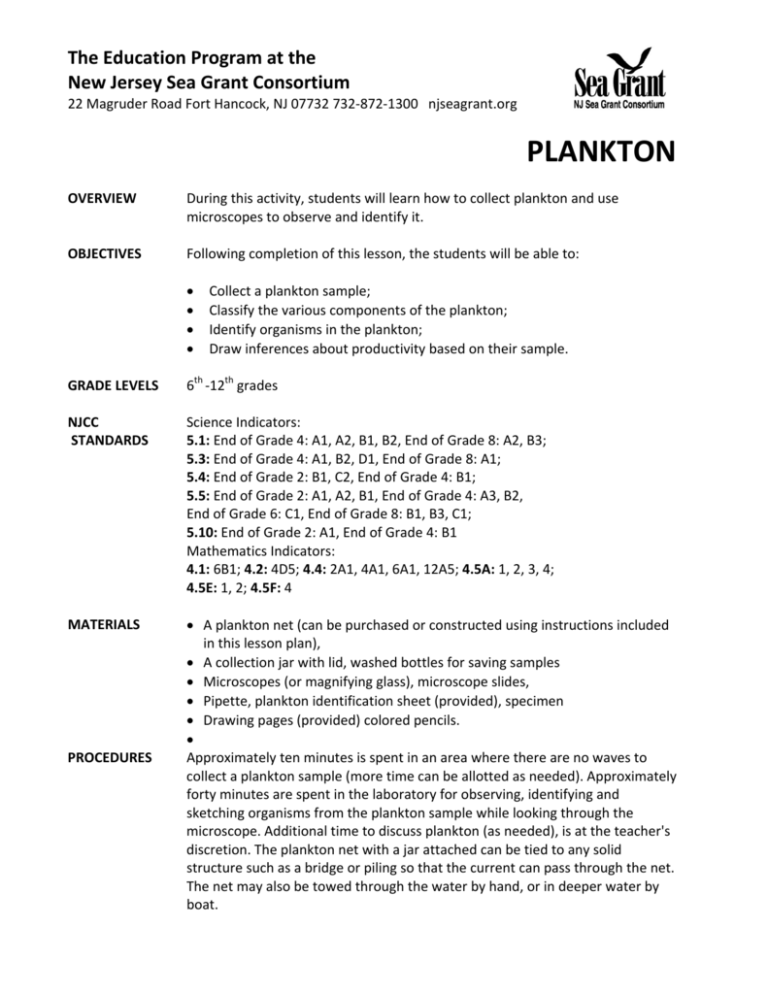
The Education Program at the New Jersey Sea Grant Consortium 22 Magruder Road Fort Hancock, NJ 07732 732‐872‐1300 njseagrant.org PLANKTON OVERVIEW OBJECTIVES GRADE LEVELS NJCC STANDARDS MATERIALS PROCEDURES During this activity, students will learn how to collect plankton and use microscopes to observe and identify it. Following completion of this lesson, the students will be able to: • Collect a plankton sample; • Classify the various components of the plankton; • Identify organisms in the plankton; • Draw inferences about productivity based on their sample. 6th ‐12th grades Science Indicators: 5.1: End of Grade 4: A1, A2, B1, B2, End of Grade 8: A2, B3; 5.3: End of Grade 4: A1, B2, D1, End of Grade 8: A1; 5.4: End of Grade 2: B1, C2, End of Grade 4: B1; 5.5: End of Grade 2: A1, A2, B1, End of Grade 4: A3, B2, End of Grade 6: C1, End of Grade 8: B1, B3, C1; 5.10: End of Grade 2: A1, End of Grade 4: B1 Mathematics Indicators: 4.1: 6B1; 4.2: 4D5; 4.4: 2A1, 4A1, 6A1, 12A5; 4.5A: 1, 2, 3, 4; 4.5E: 1, 2; 4.5F: 4 • A plankton net (can be purchased or constructed using instructions included in this lesson plan), • A collection jar with lid, washed bottles for saving samples • Microscopes (or magnifying glass), microscope slides, • Pipette, plankton identification sheet (provided), specimen • Drawing pages (provided) colored pencils. • Approximately ten minutes is spent in an area where there are no waves to collect a plankton sample (more time can be allotted as needed). Approximately forty minutes are spent in the laboratory for observing, identifying and sketching organisms from the plankton sample while looking through the microscope. Additional time to discuss plankton (as needed), is at the teacher's discretion. The plankton net with a jar attached can be tied to any solid structure such as a bridge or piling so that the current can pass through the net. The net may also be towed through the water by hand, or in deeper water by boat. A sample should be collected for at least five minutes (longer if time allows). Material that collects on the net is washed into the collection jar using seawater from a pre‐washed bottle. The sample is capped in the jar and brought back to the lab. In the lab, a few drops of well‐stirred sample from the sample bottle are to be placed on a microscope slide using a pipette and then viewed under the microscope. Students try to identify the plankton by drawing, labeling sketches and making observations. BACKGROUND VOCABULARY Plankton by definition are organisms that are unable to swim against water currents. Most plankton are so small they can only be seen using a microscope. They are very numerous and form an extremely important part of the marine food chain. Phytoplankton are producers, transforming sunlight into food energy. Producers provide food for many different primary consumers. Zooplankton is food for many secondary consumers. Detritus is typically not considered plankton or a producer because it is not living. It is placed in its own category. The amount of detritus in the water depends on how much dead and decaying plant material is going into the water. The species composition of the plankton when observed, can provide an indication of environmental health. The classic example is algal blooms associated with eutrophication, especially during large phytoplankton blooms known as "red tides." During red tides, some organisms disappear completely as water quality deteriorates, and the number of species and total overall number of different organisms found in the plankton decline. Plankton are usually categorized one of two ways: 1) feeding mode: Phytoplankton = autotroph, Zooplankton = heterotroph or 2) life cycle: holoplankton (entire life cycle in water column as plankton), meroplankton (part of life cycle as plankton). The amount of phytoplankton in the water depends on light availability, the amount of nutrients available, and the relative proportions of nutrients available (nitrogen and phosphorous are usually the limiting nutrients) and the temperature of the water. The amount of zooplankton in the water depends generally on the amount of phytoplankton and detritus available to feed on. As spring approaches and sunlight is available for longer hours and the temperature of the water rises, holoplankton and meroplankton become more abundant. Generally plankton are more abundant in coastal waters than the open ocean, and they are most abundant in estuaries and bays that can serve as nutrient traps and nursery grounds. Nearshore environments also have more terrestrial and marsh plant material to supply the detritus. Detritus can be food for primary consumers. For additional information see NJSGC’s Plankton Fact Sheet (attached). Autotrophic – An organism that through photo or chemosynthesis produces its own nutrition. Consumer ‐ An organism that gets food from eating other organisms. Also called a heterotroph. Estuarine ‐ Of or pertaining to estuaries. An estuary is a place where salt water and fresh water meet and mix. Eutrophication ‐ The process by which a body of water becomes rich in nutrients either naturally or through pollution, and biological productivity is stimulated. Food chain – All living things depend on each other to live. The food chain is an example of how some animals may eat other animals or plants to survive. The food chain is a complex balance of life. If one animal’s source of food disappears such as from over fishing or hunting, many other animals in the food chain are impacted and may die. Heterotrophic – Any organism that is not autotropic: a secondary producer. Utilizes the organic material produced by an autotrophic organism. Plankton ‐ Organisms such as jellyfish, seaweeds, and microscopic plants and animals that passively drift or are weak swimmers and are not independent of the currents. Any plankton sample can contain: Detritus ‐ Dead and decaying organic material. Phytoplankton ‐ Plant plankton. The most important community of primary producers in the ocean. Zooplankton ‐ Animal plankton (primary consumer). Holoplankton ‐ Organisms that spend their entire life as plankton. This group includes krill, copepods, sea snails, slugs, salps, jellyfish and a small number of marine worms. Meroplankton ‐ Microscopic larval forms of organisms that spend their adult lives as nekton (organisms that swim in the ocean freely) or benthos (organisms that live on the ocean floor). This group includes sea urchins, starfish, sea squirts, most of the sea snails and slugs, crabs, lobsters, octopus, marine worms and most fish. EXTENSIONS Producer ‐ An organism that makes it own food. Also called an autotroph. Have students create a plankton scrapbook by compiling their drawings into a book. Use the sample specimen sheet included in this lesson plan. Discuss how longer spines, antennae, and cilia that they see on the organisms of their sample help keep the organisms suspended in the water and keep phytoplankton closer to their light source and zooplankton closer to their food source. Collect samples from different locations, at different stages of the tide, at different times of day, and at different times of year. Discuss what time of year more plankton and different kinds of planktonic organisms are observed and why this may be. REFERENCES See STUDENT WORKSHEET 1 included in this lesson plan. Internet Resources: http://www.chesapeakebay.net/plankton.aspx?menuitem=19401 http://www.mos.org/oceans/ http://www.nhptv.org/natureworks/nwep6j.htm REV. 11/11/10 The New Jersey Sea Grant Consortium (NJSGC) is an affiliation of colleges, universities and other groups dedicated to advancing knowledge and stewardship of New Jersey’s marine and coastal environment. NJSGC meets its mission through its innovative research, education and outreach programs. For more information about NJSGC, visit njseagrant.org. The Education Program at the New Jersey Sea Grant Consortium 22 Magruder Road Fort Hancock, NJ 07732 732‐872‐1300 njseagrant.org The New Jersey Sea Grant Consortium (NJSGC) is an affiliation of colleges, universities and other groups dedicated to advancing knowledge and stewardship of New Jersey’s marine and coastal environment. NJSGC meets its mission through its innovative research, education and outreach programs. For more information about NJSGC, visit njseagrant.org. The Education Program at the New Jersey Sea Grant Consortium 22 Magruder Road Fort Hancock, NJ 07732 732‐872‐1300 njseagrant.org STUDENT WORKSHEET 1: Plankton Productivity Name: _________________________ The productivity of phytoplankton depends on the availability of sunlight and nutrients, (nutrients are most available in the spring and fall) the relative proportions of nutrients, (nitrogen and phosphorus are usually limiting) and temperature. 1) Over a 24‐hour period, when is phytoplankton productivity highest? 2) There are lots of nutrients in colder polar waters. Why is annual phytoplankton productivity usually low? 3) There is an abundance of sunlight in warmer tropical waters. Why is phytoplankton productivity usually low? 4) In a certain estuary, the availability of nitrogen is what limits phytoplankton productivity in the summer time. If the people living near this estuary fertilize their lawns with phosphates (contain phosphorous) and it washes into the estuary, will the phytoplankton be more productive? Why? 5) The productivity of zooplankton depends on the availability of phytoplankton, detritus and temperature. At what time of year is zooplankton productivity highest in temperate zones? Why? 6) In what climate zone is annual zooplankton productivity highest? Why? 7) Is zooplankton productivity higher in the open ocean or in coastal waters? Why? The Education Program at the New Jersey Sea Grant Consortium 22 Magruder Road Fort Hancock, NJ 07732 732‐872‐1300 njseagrant.org STUDENT WORKSHEET ANSWERS 1) Phytoplankton productivity is the highest during daylight hours. 2) Sunlight availability in Polar Regions is low during the winter months and water temperatures are much colder and as a result phytoplankton growth is slower. 3) The availability of nutrients is limited. Tropical waters are oligotrophic which means that they are nutrient‐poor. 4) No, the phytoplankton will not be more productive. Phosphorus is not limiting; there is enough of it. What is needed is more nitrogen because this is the limiting nutrient. 5) During the spring zooplankton productivity is highest in temperate zones. Temperatures are warmer and there are longer hours of sunlight and greater amounts of nutrients available. This makes phytoplankton bloom becoming food for zooplankton. Warmer temperatures also stimulated zooplankton growth. Zooplankton predators are not around yet to eat the zooplankton. Lastly, spring floods carry lots of detritus into the water. 6) Annual zooplankton productivity is highest in the temperate zone because this is where the combination of nutrient availability, sunlight availability and temperature are best for phytoplankton growth (see answer to #2 & 3, for details). 7) Coastal waters provide the most food for zooplankton. There is plenty of sunlight available in the open ocean for phytoplankton production, but nutrients are limited most of the time. Phytoplankton productivity is higher in coastal waters where there are lots of nutrients and sunlight. There is also more detritus in coastal waters because most detritus comes from the land and marshes. The Education Program at the New Jersey Sea Grant Consortium 22 Magruder Road Fort Hancock, NJ 07732 732‐872‐1300 njseagrant.org SPECIMEN DRAWING PAGE Scientist: _______________________________ Date: ________________________ Sketch of Specimen: Observations/Comments: The Education Program at the New Jersey Sea Grant Consortium 22 Magruder Road Fort Hancock, NJ 07732 732‐872‐1300 njseagrant.org How to Construct a Plankton Net *Wide‐mouth glass or plastic jars with lids (baby food jars are fine) *One nylon stocking (pantyhose not suggested) *One wire clothes hanger *1/2 ounce lead fishing weight *Rubber bands *Large needle and/or epoxy glue *Nylon string *Lightweight rope *Wire cutters *One metal ring (large washer or key ring suggested) *Needle and thread After you have your materials assembled: 1. Detach top of hanger with wire cutter‐and bend remainder of hanger into a circle by twisting the ends together. Snip off any excess with wire cutters, exercising caution. 2. Start on the inside of the wire loop; fold the hem of an old stocking over the top. Stitch the stocking to itself several inches down from the wire loop. 3. Snip off the toe at the bottom of the stocking, and attach a jar to this opening using a rubber band. 4. Tie three equal lengths of nylon string (1 to 1‐ 1/2 ft.) to the metal ring. Use a darning needle to force the opposite end of the string, through the stocking and tie it around the wire hoop. You can also epoxy these ends in place, allowing at least 24 hours of drying time. 5. Tie a length of rope onto the ring. Give yourself enough length. This will be your towline. Now tie a string, approximately 2 feet long, to the wire hoop with the lead fishing weight on the opposite end of it. 6. To collect a sample, tow your net through the water. If the water is moving, as is the case with tidal waters coming out of an estuary, tie your line someplace on shore, allowing your net to drift in the moving waters before reeling it back in. Retrieve your net, detach the collection bottle, and tightly screw on the lid. Remember to label samples with time, date, conditions and location. Refrigerate samples until you are ready to examine them. The Education Program at the New Jersey Sea Grant Consortium 22 Magruder Road Fort Hancock, NJ 07732 732‐872‐1300 njseagrant.org How to Construct a Soda Bottle Plankton Net Materials: • • • • • • • One two‐liter soda bottle with cap One Nylon knee high stocking Nylon or other heavy‐duty string (about 9 feet) Duct Tape Scissors Hole Puncher Small Collection jar (baby food jars are fine) After you have your material assembled: Remove cap from soda bottle and set aside and flatten out soda bottle as much as possible. 1. Cut the soda bottle at 2 places to have 3 separate parts. (see figure 1) a. The first cut should be made about 3 inches down from the neck of the bottle. b. The second should be made about 4 inches down from the first cut. c. Recycle the bottom part of the bottle. 2. Cut small hole at toe of nylon stocking. 3. Slide top portion of bottle through stocking so neck of bottle is sticking through hole in toe. Pull till snug then tape in place. Attach middle of bottle to other end of stocking. (see figure 2) 4. Punch 3 holes evenly spaced apart around the open end (the end not attached to the nylon stocking) of the middle portion of the soda bottle. (see figure 2) 5. Cut string into 3 three‐foot pieces; attach each string to a hole. 6. Tie the 3 pieces of string together at the end to make a tow line. (see figure 2) 7. Replace cap onto neck of your new plankton net. 8. Wade through water with open end of the plankton net moving through the surface water, be careful NOT to drag on the bottom of the seafloor and fill with sand. Plankton will collect on the nylon stocking of your plankton net; squeeze down while in the water to collect into capped neck of the bottle. 9. Remove cap to pour collected sample into collection jar. The Education Program at the New Jersey Sea Grant Consortium 22 Magruder Road Fort Hancock, NJ 07732 732‐872‐1300 njseagrant.org The community of life in the sea can be likened to a pyramid. At the base of the pyramid is a multitude of microscopic plants and animals called plankton, a word that means "to wonder or drift". These living specks that range in size from a thousandths of a millimeter to some that are 2 millimeters or more in size, include all of the sea organisms that are too small or too weak to do anything but drift or wander about at the mercy of the currents and tides. This plankton supports a smaller number of larger forms which feed on them, and these in turn, a still smaller number of larger organisms, are fed upon by still fewer and larger organisms. Finally, at the top of the pyramid are the relatively few large fish and other sizable sea creatures that could not exist without all of the intervening layers of organisms in the pyramid. An example of the life and death involved in a single food chain would be to look at the stomach of the Hump‐back Whale, which needs a ton of herring (5000 or more individuals) to feel full. Each herring in turn may well have six or seven thousand small crustaceans in its own stomach, each of which may have as many as one hundred and thirty thousand diatoms in them. In other words, some four hundred billion yellow‐green diatoms sustain a medium‐sized whale for only a few hours at most. Not only do the numbers of organisms increase as you go down the pyramid, so does the size of each organism get smaller. At sea, as on land, the whole animal kingdom depends upon the plant kingdom for food. Plants alone are able to capture the energy of sunlight and use it in making sugars, starches and proteins that animals live on. The seaweeds found along the shores play a part in this process, but in the total chain of sea life it is a small part. More than 99 percent of all plant life in the sea consists of the microscopic phytoplankton floating in the upper hundred feet or so of the ocean. Of the thousands of different kinds of drifting single‐ celled plants, many will live only in water of certain temperatures or salinity. By far the most important of the drifting phytoplankton are the single‐celled algae known as diatoms, which constitute six‐tenths of all planktonic life. Each diatom is a transparent crystal case with a single plant cell inside which viewed under the microscope look like a collection of tiny flashing bracelets, pendants, needles and anchors. Each tiny creature manufactures its own "house" from the minerals in the sea around it, building the walls from the same silica that sand is made of. Many odd projections help them float in the water. Just as land plants depend upon minerals in the soil for growth, these tiny sea plants depend upon the nutrient salts and minerals in the seawater. In the spring, the oceans having been deeply stirred by winter storms, bringing to the surface a rich supply of bottom water. This nutrient rich water plus the increasing hours of sunlight, rouses the diatoms into a fierce intensity of growth. Hundreds of square miles of oceans surface will be tinged yellow or brown or green as the sea takes on the color hue of the grains of color contained in each tiny plant cell. The creatures have taken off on a veritable binge of diatom guzzling. Also present in the thick planktonic soup are swarms of equally minute animal forms called Zooplankton. These animal forms include representatives of almost every phylum of the animal kingdom, including larvae and fingerlings of thousands of kinds of invertebrates and marine fish. Many of the zooplankton are found as plankton for only a brief part of their life. Only an infinitesimal fraction of all the eggs and young larval forms of life ever reach adulthood. About one creature in 10 million escapes a violent death, and that is usually inside the stomach of another sea creature. This fact gives testimony to the prolific propagation rates of sea creatures. Some scientists have calculated that if all of the eggs laid by codfish were hatched and grew to maturity, the Atlantic would be packed solid with codfish within six years. Of course, nature doesn't let this happen. Probably the most numerous of the zooplankton organisms are the copepods. The copepods may be of either the herbivorous or carnivorous type, with the plant eating herbivores most numerous. These plankton types thus provide food for many larger animals. Another type of plankton that is important to note are the radiolarians, which have skeletons that resemble tiny “snow crystals”. There are over 4,000 different types of radiolarians which live from the surface waters to the mid‐depths of the oceans. These tiny “snow crystals” are made up of a dense inner layer of cytoplasm, which is separated from an outer frothy layer and by a central capsule pierced by systems of pores. Outside the capsule is the skeleton, usually made of silica. Radiating from the capsule are fine threads of moving cytoplasm, a trap for small planktonic organisms, which are digested in the outer cytoplasm. Foraminiferans have a similar means of catching food. They have fine threads of cytoplasm, which emerge through a calcium carbonate shell. There are nearly 1,200 species of marine foraminifers which range from 20 thousands of a millimeter to a size of 15 millimeters. Today calcareous sediments that are rich in their shells exist on over nearly half of the deep‐sea floor. The remains of the coiled foraminifers shells can be found in core samples from the sea floor. One fossil species, Globorotalia menardi is found only in warm water sediments and can be used as a climate indicator for dates in the geologic past. Their absence can indicate a cold climate trend, such as times of glacial activity. Other foraminiferans are used as climate indicators due to their change in coiling direction with change in water temperature. Plankton also includes the plant‐animal, dinoflagellates, which are tiny specks that can move with whip‐ like feelers and eat other things but are also able to make their own food. Some dinoflagellates radiate an eerie glow of luminescence (a chemical reaction touched off in organisms by the disturbance of the sea). The New Jersey Sea Grant Consortium (NJSGC) is an affiliation of colleges, universities and other groups dedicated to advancing knowledge and stewardship of New Jersey’s marine and coastal environment. NJSGC meets its mission through its innovative research, education and outreach programs. For more information about NJSGC, visit njseagrant.org.



